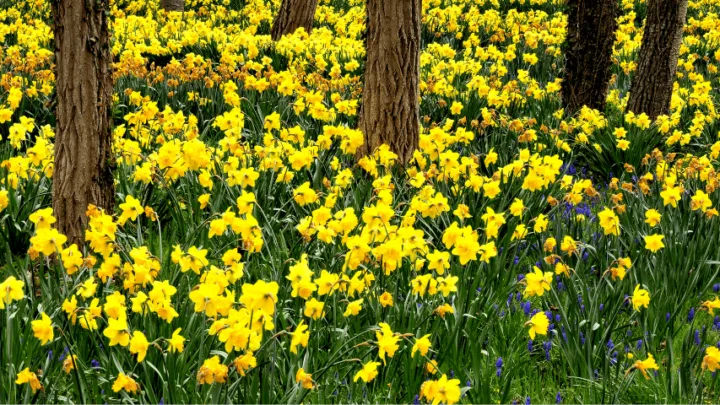In the shadow, lawn grass does not thrive. Fruit and vegetables, and other plant species do not survive in the shade.
Plants beneath trees fight for nutrients and water, and the branches of the tree create shades in the space and the limited sunlight.
Plants that thrive under trees bloom for less time than those that thrive in direct sunlight.
The exquisite elegance of a shaded landscape comes from complementary groups of foliage colors and textures and a steady movement of short-lived flowering phases from various plants across the ground.
Rather than large expanses of bright flowers. With these shade-loving plants, you may start to plan your shade garden right now.
30 Best Plants for Under Trees
- Azalea
- Bluebell
- Mahonia
- Hosta
- New Guinea Impatiens
- Primrose
- Siberian Bugloss
- Mountain Laurel
- White Dogwood
- Japanese Painted Fern
- Foam Flowers
- Wild Columbine
- Solomon’s Seal
- Hens and Chicks
- Angel Wing Begonia
- Aquilegias
- Siberian Irises
- Lesser Periwinkle
- Bloodroot
- Rheinland Astilbe
- Comfrey
- Lamium
- Ivory Prince Lenten Rose
- Foxglove
- Japanese Spurge
- Daffodil
- Coral Bells
- Anemones
- Golden Japanese Forest Grass
- Wild Ginger
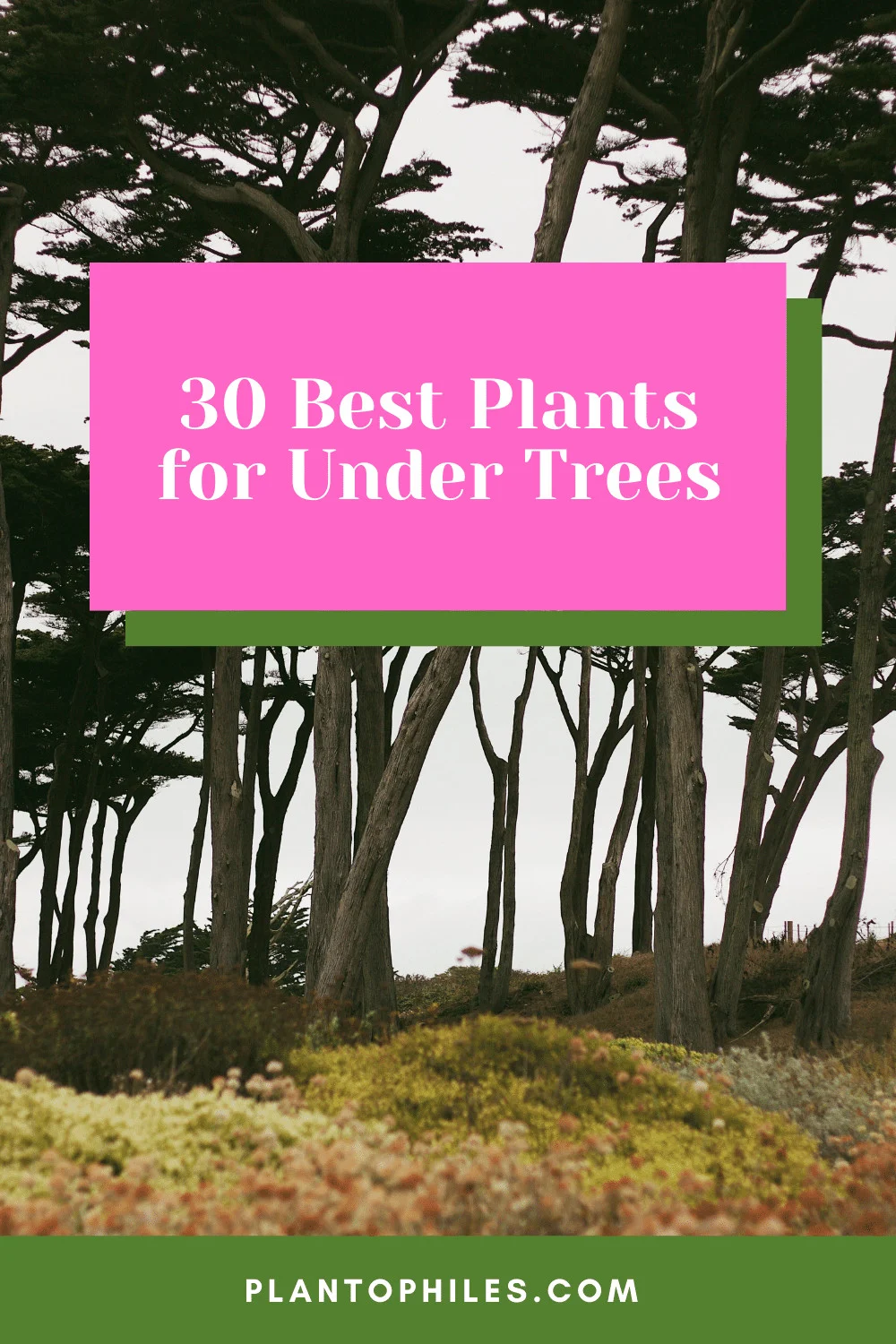
30 Best Plants for Under Trees
Best Plants for Under Trees
1. Azalea
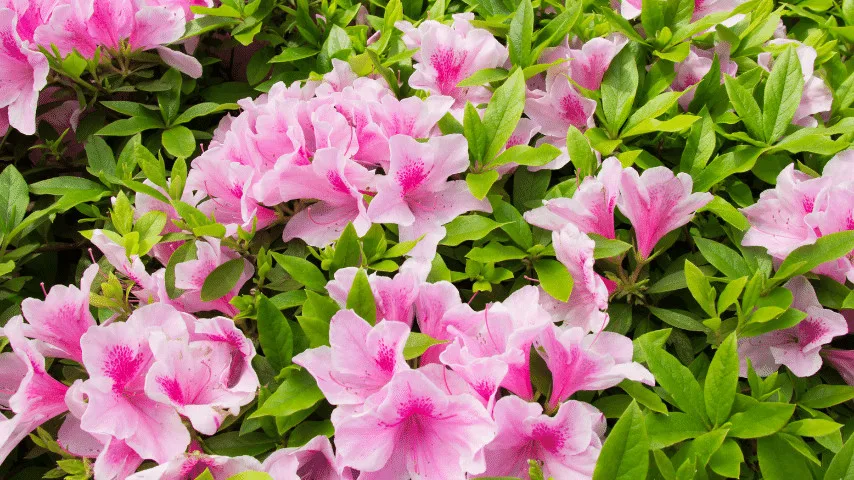
Azalea suggested adding a splash of brightness beneath any tree due to their wonderful multi-colored blossoms
Azaleas are excellent plants for planting under trees. The azalea shrub is a part of the Rhododendron family that favors shade and requires acidic soil.
Azaleas are widely suggested to add a splash of brightness beneath any tree due to their wonderful multi-colored blossoms.
Some varietis produce an abundance of flowers and evergreen azaleas even hold their years for the whole year according to the University of Florida.
The only drawback is that it takes a lot of maintenance. The region beneath the trees can offer an ideal growing environment for azaleas.
A nitrogen deficit in the soil is one problem that you should anticipate.
- Scientific Name: Rhododendron
- Size: 20 feet (6.096 m) or more
- Zones: USDA hardiness zones 6-9
- Fertilizer: A general, balanced fertilizer with an NPK ratio of 15-15-15
- Growth rate: Fast grower
- Temperature: 55 to 60 degrees Fahrenheit (12 to 15 degrees Celsius)
- Lighting: Part shade or full sun (about four hours of light)
- Humidity: 40% or higher
2. Bluebell
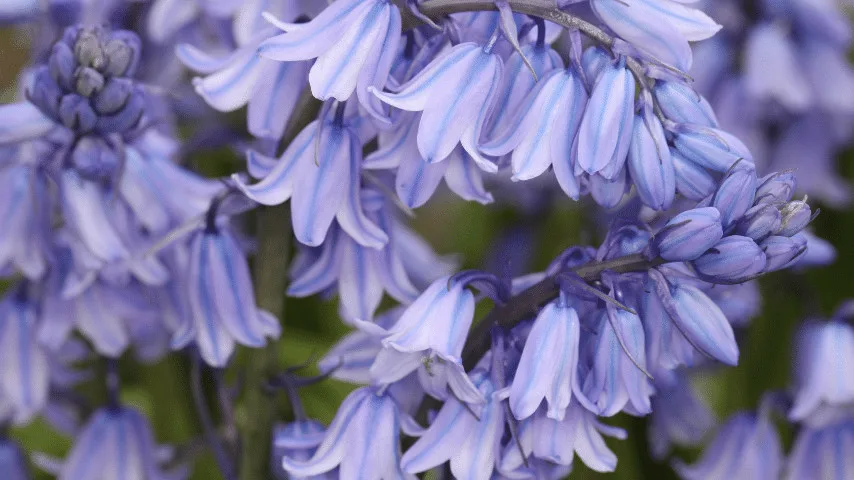
Bluebell natural wildflower with many possibilities for growing beneath trees
The bluebell shrub, a natural wildflower with many possibilities for growing beneath trees, can brighten up this ignored region with its aromatic blossoms.
The blossoming season for bluebells begins in the spring. These delicate perennials come in a broad array of colors.
Colors of dark purple to pale blues and white are to be expected. Bluebells should be planted in the fall to appreciate their spring beauty.
These flowers, often known as wood hyacinths, are simple to cultivate and require no upkeep.
- Scientific Name: Hyacinthoides non-scripta
- Size: 1 foot (0.3 m) in length
- Zones: USDA hardiness zones 4-6
- Fertilizer: Specialized flower fertilizer lower in nitrogen and high in phosphorus and potassium
- Growth rate: Moderate
- Temperature: Surviving in temperatures as low as -20 degrees Fahrenheit (-28 degrees Celsius)
- Lighting: In spots with dappled shade
- Humidity: 60% relative humidity
3. Mahonia
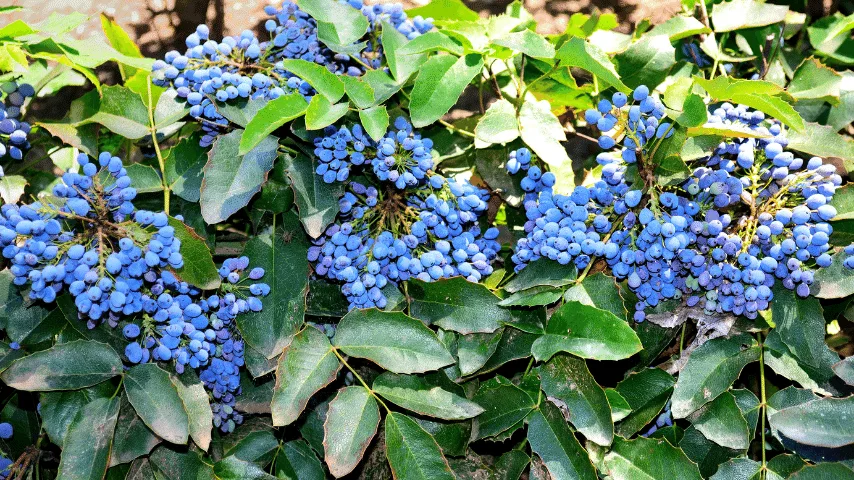
Mahonia forms a great, robust shrub best planted beneath trees
It blossoms in the spring and bears blue-black fruits that birds adore. But when it comes to picking the best plants beneath trees, we believe that it forms a great, robust shrub.
Ensure to cover all around the bottom yearly and water daily in dry situations.
- Scientific Name: Mahonia
- Size: 5 to 7 feet (1.5-2.1 m) in height
- Zones: USDA hardiness zones 6-9
- Fertilizer: A slow-release, low-nitrogen fertilizer
- Growth rate: Slow growers
- Temperature: -4 degrees Fahrenheit (-20 degrees Celsius)
- Lighting: Tolerate full sun and heavy shade
- Humidity: Moderate
4. Hosta
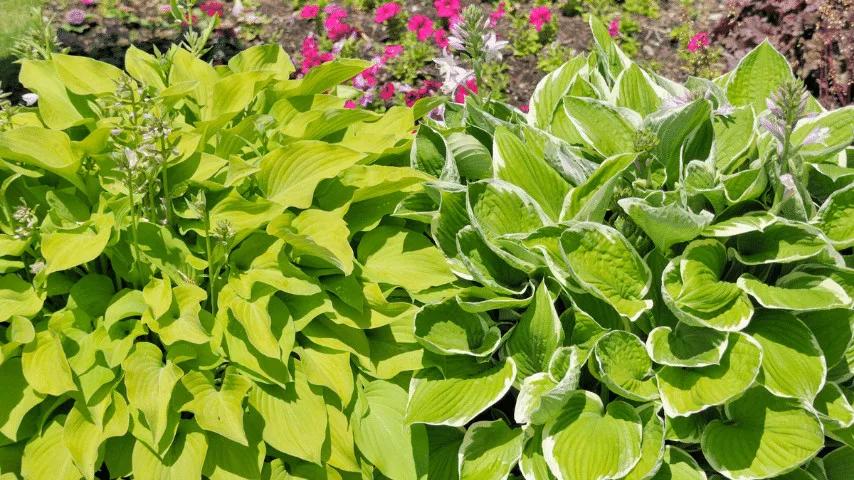
Hosta brings lush succulent leaves in various hues and shapes to the shadow landscape beneath the trees
Hostas, sometimes called plantain lilies, bring lush succulent leaves in various hues and shapes to the shadow landscape and midsummer flower stalks.
- Scientific Name: Hosta
- Size: 4 to 6 feet (1.2-1.8 m) tall
- Zones: USDA hardiness zones 3-8
- Fertilizer: A slow-release NPK 10-10-10 fertilizer
- Growth rate: Slow grower
- Temperature: 33 to 41 degrees Fahrenheit (0.5-5 degrees Celsius)
- Lighting: Dappled or partial shade
- Humidity: Moderate
5. New Guinea Impatiens
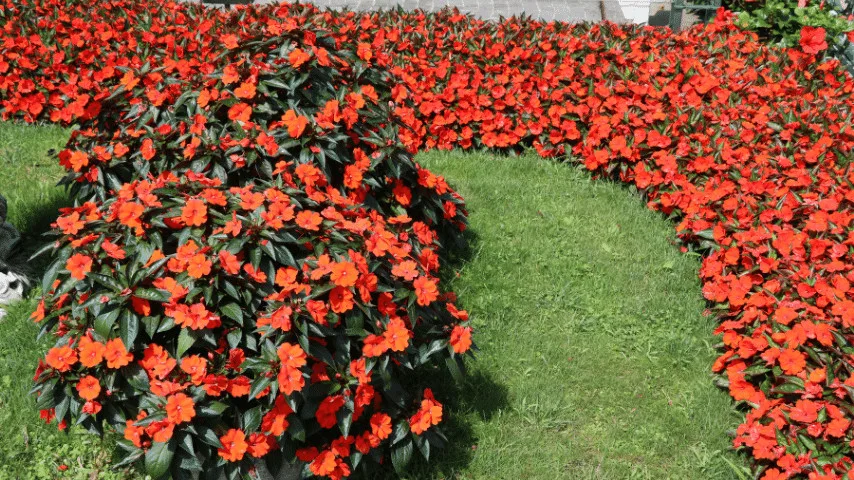
New Guinea Impatiens In shaded gardening, use it to give pockets of color plants under trees
All through the growth period, New Guinea Impatiens produce a steady stream of blooms.
In shaded gardening, use it to give pockets of color beside the patio or terrace, across pathways, or nestled among other plants under trees.
- Scientific Name: Impatiens hawkeri
- Size: 1 to 1.25 feet (0.3-0.4 m) tall
- Zones: USDA hardiness zones 10-12
- Fertilizer: Water-soluble fertilizer every three to four weeks
- Growth rate: Fast grower
- Temperature: 55 to 85 degrees Fahrenheit (12 to 29 degrees Celsius)
- Lighting: Morning sun and afternoon shade
- Humidity: Above 75%
6. Primrose
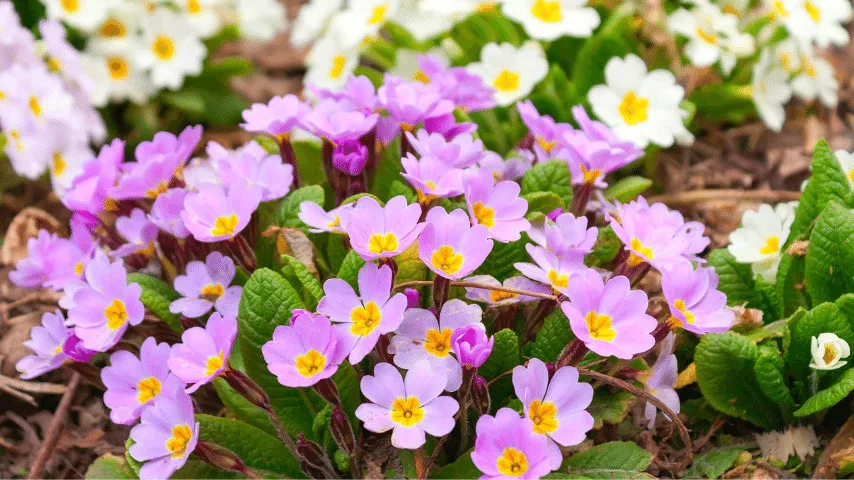
Primroses are an excellent way to freshen up the area beneath the tree
Primroses are an excellent way to freshen up the area beneath the tree. This cheerful-looking flower grows well in moist shade.
The plant’s flowering season might stretch through the summertime, a wonderful feature of primrose.
Primroses can occasionally bloom in the fall, though this is harder for plants planted under trees.
The overall resilience of this plant is the major reason it is suggested for cultivation in such a challenging environment.
When it comes to adjusting to varied environments, primroses are amazing.
- Scientific Name: Primula vulgaris
- Size: 5 to 1.6 feet (0.2-0.5 m) tall
- Zones: USDA hardiness zones 4-8
- Fertilizer: A balanced fertilizer or a bloom booster in early spring
- Growth rate: Moderate
- Temperature: 50 to 80 degrees Fahrenheit (10-26 degrees Celsius)
- Lighting: Shady or dappled corner
- Humidity: Above 50%
7. Siberian Bugloss
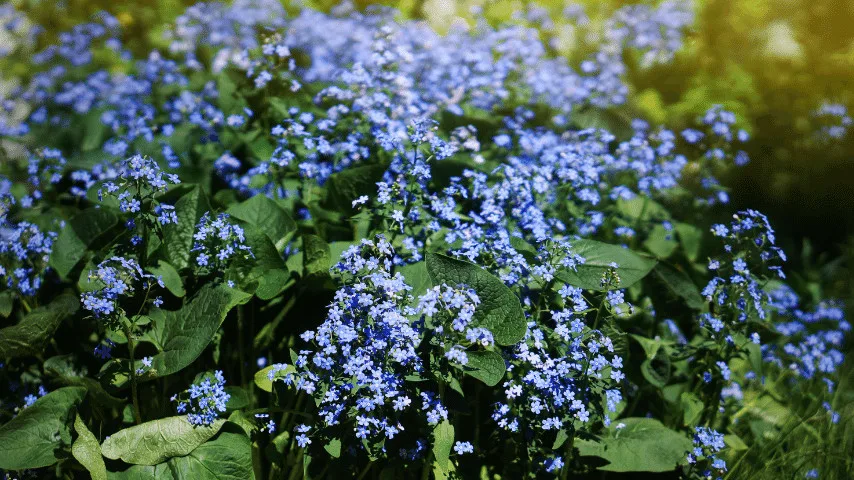
Siberian bugloss is another gorgeous shade-loving plant under the trees
Siberian bugloss is yet another gorgeous shade-loving plant. It has the appearance of a bigger, more powerful forget-me-not, with beautiful blue flowers in the spring and a resistant character.
Pearly leaves contribute to the aesthetic value of several varieties, such as ‘Jack Frost’ and ‘Sea Heart.’
They can thrive in arid, shady areas under trees but thrive even more if the ground is maintained wet yet well-drained.
They require little care and are pest resistant.
- Scientific Name: Brunnera macrophylla
- Size: 1 to 1.5 feet (0.3-0.45 ) tall
- Zones: USDA hardiness zones 3-8
- Fertilizer: Organic liquid fertilizer in spring and summer twice every year
- Growth rate: Slow grower
- Temperature: 50 to 65 degrees Fahrenheit (10-18 degrees Celsius)
- Lighting: Shady spots but can survive in full sun
- Humidity: Moderate
8. Mountain Laurel
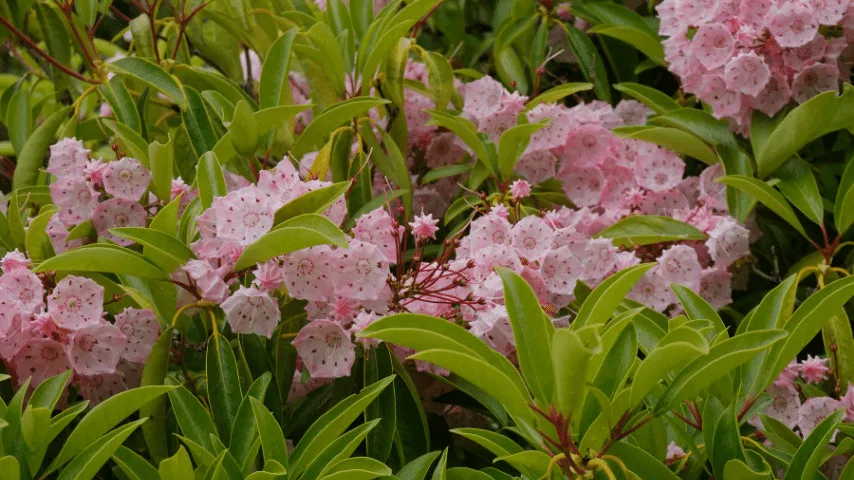
Mountain Laurel has some of the most beautiful spring blossoms, shaded hillsides and alongside stream edges, and under the trees
Mountain Laurel grows wild in the southeast United States on cold, shaded hillsides and alongside stream edges.
Mountain Laurel has some of the most beautiful spring blossoms, and it grows with minimal support.
It can thrive in various circumstances, such as thick soils, cold weather, and the warm, moist climate of the Southeast.
Mountain Laurel’s evergreen leaves make it a good decorative or structural plant around the property.
- Scientific Name: Kalmia latifolia
- Size: 6 to 15 feet (1.8-4.5 m) tall
- Zones: USDA hardiness zones 5-9
- Fertilizer: Acid-loving, balanced plant fertilizer
- Growth rate: Slow grower
- Temperature: Surviving in temperatures as low as -9 degrees Fahrenheit (-22.78 degrees Celsius)
- Lighting: Deep shade to full sun
- Humidity: Moderate
9. White Dogwood
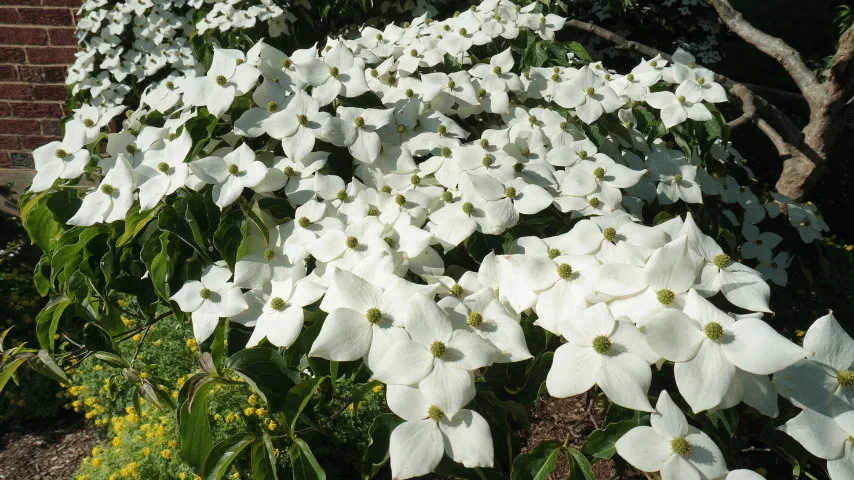
White Dogwood a little blooming tree, will be perfect
Try putting some pattern and vibrancy among the “top” and “bottom” of your yard if the big dominating trees in your area make a tall, unstructured overhead.
A little blooming tree, such as White Dogwood, will be perfect. When planted as an understory tree, White Dogwood has a stunning multilayered branch structure.
The white blossoms on usually naked branches produce a lovely cloudlike impression under trees when they flower.
- Scientific Name: Cornus florida
- Size: 15 to 25 feet (4.5-7.6 m) tall
- Zones: USDA hardiness zones 5-9
- Fertilizer: Slow-release tree or shrub fertilizer
- Growth rate: Slow grower
- Temperature: Growth temperature between 10 to 15 degrees Fahrenheit (-12 to -15)
- Lighting: Prefer afternoon shade
- Humidity: 75%
Read more about growing Dogwood.
10. Japanese Painted Fern
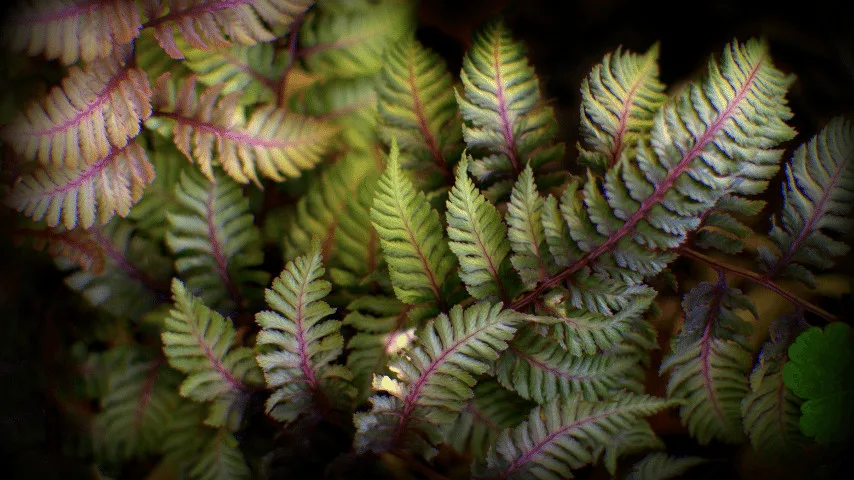
Japanese Painted Fern good shadow plant to choose for cultivating under trees
The Japanese painted fern is a good shadow plant to choose for cultivating under trees because it has several beautiful properties.
It distinguishes itself from the more common green ferns by having silvery, purple-tinged leaves.
While the hue may not appear as vibrant in direct sunlight, it comes alive in the diffused shade.
The Japanese painted fern is great for covering the space beneath the trees because of this.
- Scientific Name: Athyrium niponicum
- Size: 5 to 24 feet (0.5-0.6 m) tall
- Zones: USDA hardiness zones 5-8
- Fertilizer: A balanced fertilizer in spring
- Growth rate: Moderate
- Temperature: 55 to 80 degrees Fahrenheit (12-26 degrees Celsius)
- Lighting: Partial shade or full shade
- Humidity: 40% to 60%
11. Foam Flowers
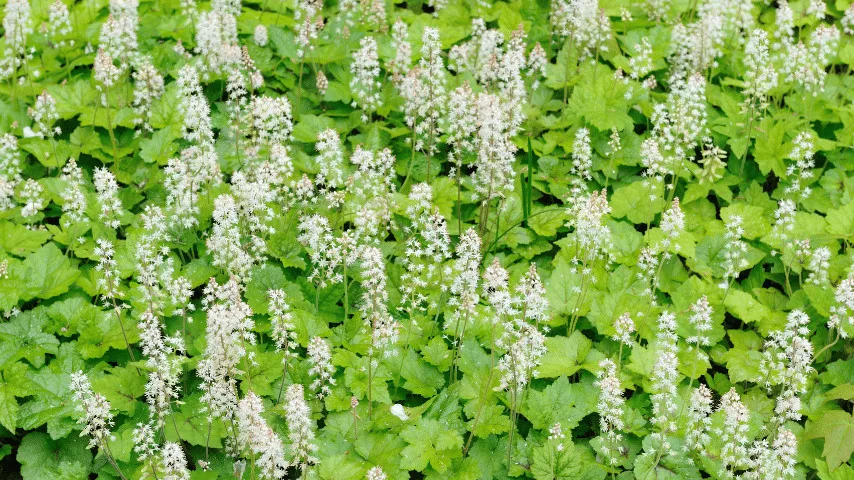
Foam Flowers are lovely shade-loving leaf species for cultivating under trees
The Tiarella genus is a lovely shade-loving leaf species for woodland gardening.
Tiarellas grow a small pile of green leaves with displays of tiny, beautiful blooms.
There has not been a greater moment to gather and cultivate these lovely forest perennials than in the last 15 years when many new varieties have been created and made public to horticulturalists.
- Scientific Name: Tiarella cordifolia
- Size: 1 to 3 feet (0.3-0.9 m)
- Zones: USDA hardiness zones 4-9
- Fertilizer: Organic fertilizer in early spring
- Growth rate: Slow grower
- Lighting: Part shade to full shade
- Humidity: Moderate
12. Wild Columbine
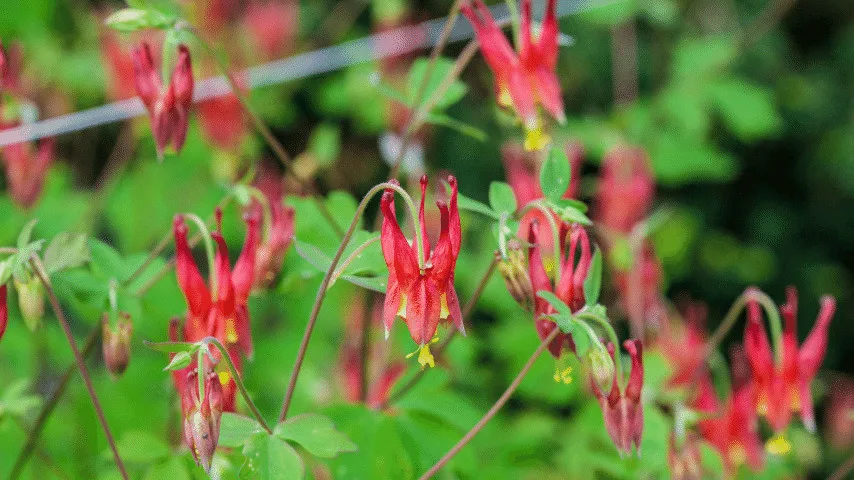
Wild Columbines aren’t just pretty to look at; they also add to the liveliness of the region beneath the trees
In its native environment, this flower can be seen in forest grasslands
Despite being a wild species, it bears remarkable similarities to the domestic columbine.
The aesthetic attributes are extremely similar given the bell-like blooms with a hanging aspect.
The blossoms of the wild columbine aren’t just pretty to look at; they also add to the liveliness of the region beneath the trees.
They will also draw useful bugs and hummingbirds in quest of the tasty nectar stored within the blossoms.
- Scientific Name: Aquilegia canadensis
- Size: 1 to 3 feet (0.3-0.9 m)
- Zones: USDA hardiness zones 3-8
- Fertilizer: Water-soluble once a month throughout spring to fall
- Growth rate: Moderate
- Temperature: 70 degrees Fahrenheit (21 degrees Celsius)
- Lighting: Partial shade but can tolerate full sun
- Humidity: Moderate
13. Solomon’s Seal
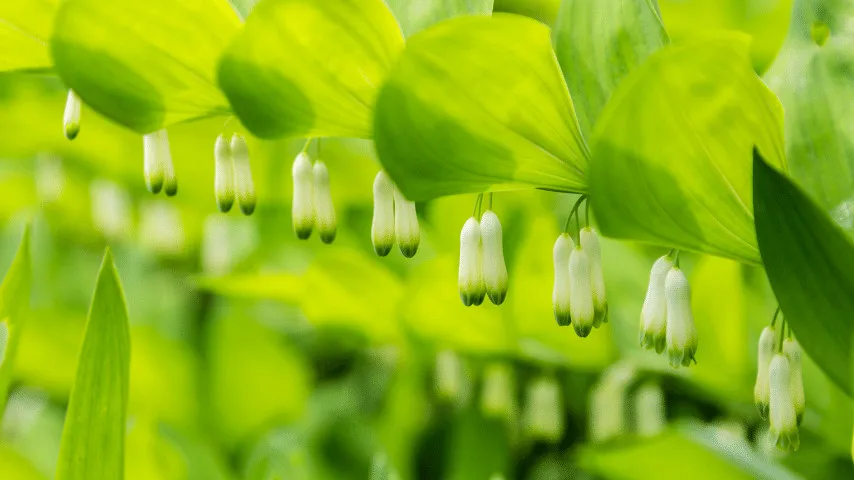
Solomon’s seal flower looks great in a spectacular show with huge trees
Solomon’s seal flower is an excellent option for any forest landscape, and it looks great in a spectacular show with huge trees.
This plant is commonly used as a land cover in shady locations by landscapers. The plant’s capacity to withstand deer is highly valued.
The bell-shaped flowers on the arched stalks make this plant even more beautiful.
The white flowers bloom in the middle of spring and might continue until the beginning of summer.
Late in the summer, when the flowering time has passed, berry-like fruits will begin to appear.
- Scientific Name: Polygonatum
- Size: 1 to 2 feet (0.3-0.6 m)
- Zones: USDA hardiness zones 3-9
- Fertilizer: Organic fertilizer once a year
- Growth rate: Moderate
- Temperature: Minimum temperature -30 to -20 degrees Fahrenheit (-34 to -28 degrees Celsius)
- Lighting: Partial to full sun
- Humidity: Moderate
14. Hens and Chicks
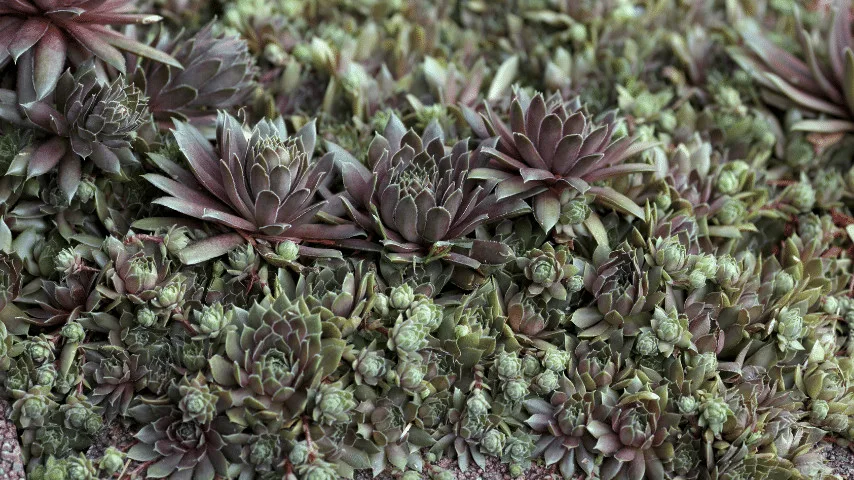
Hens and Chicks are ideal for filling in gaps among rocks or areas beneath your trees
In Zone 3, hens and chicks are among the few plants that can be grown as annual (though there are others).
They’re ideal for filling in gaps among rocks or areas beneath your trees where nothing unusual will thrive.
- Scientific Name: Sempervivum tectorum
- Size: 5 to 1 foot (0.1-0.3 m) tall
- Zones: USDA hardiness zones 3-8
- Fertilizer: Do not require fertilizing
- Growth rate: Moderately quick grower
- Temperature: 65 to 75 degrees Fahrenheit (18-23 degrees Celsius)
- Lighting: Full sun to partial shade
- Humidity: Moderate
15. Angel Wing Begonia
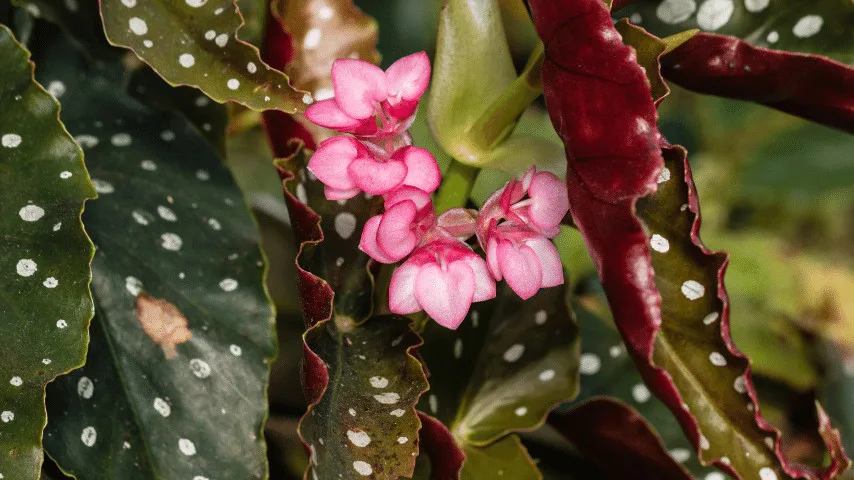
Angel Wing Begonias have enormous glossy foliage for cultivating under trees
Begonias are a fantastic option for cultivating a perennial flower beside your covered letterbox, in a container next to the front entrance, or under trees.
Angel Wing Begonias have enormous glossy foliage and blossom in pink or red.
They’re simple to cultivate and flower continually from April to fall’s initial frost.
Angel Wing Begonias thrive in shaded sunshine, they’re perfect for planting under trees.
- Scientific Name: Begonia’ Angel Wing’
- Size: 1 to 2.5 feet (0.3-0.7 m) tall
- Zones: USDA hardiness zones 10-11
- Fertilizer: Liquid fertilizer on a weekly or biweekly basis
- Growth rate: Moderately quick
- Temperature: 65 to 75 degrees Fahrenheit (18 to 23 degrees Celsius)
- Lighting: Bright, indirect sunlight
- Humidity: 50% or more
16. Aquilegias
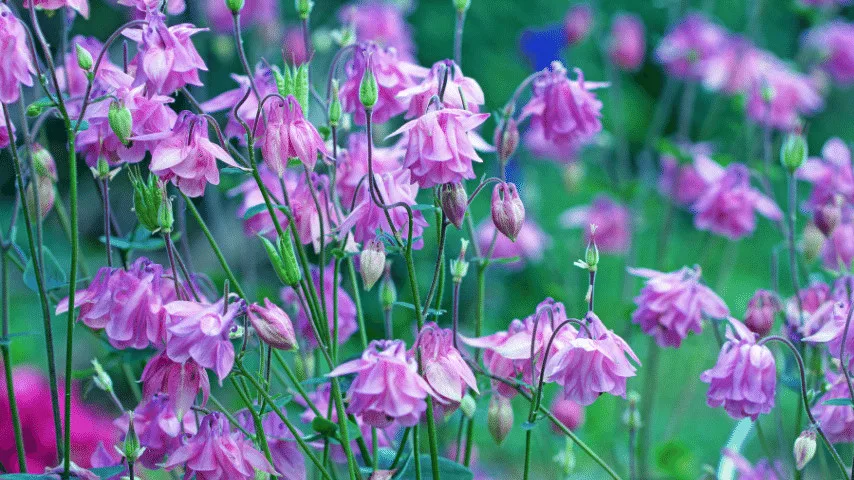
Aquilegias are lovely flowers to choose for planting under trees
Aquilegias are yet another lovely flower to choose for planting under trees. This is largely due to this species’ capability to grow in partial shade.
The aquilegia flower is perfect for a cottage landscape, but it can also look great in a wooded environment.
This plant’s blossoms have a bonnet shape, making it a lovely way to blanket the ground beneath trees.
The aquilegias are expected to blossom in early June. You will not be dissatisfied with the variety. Plants of the genus Aquilegia come in a variety of colors.
- Scientific Name: Aquilegia
- Size: 18 to 36 inches (45-90 cm) tall
- Zones: USDA hardiness zone 3
- Fertilizer: Mineral-based fertilizer during spring
- Growth rate: Slow grower
- Temperature: 70 to 72 degrees Fahrenheit (21-22 degrees Celsius)
- Lighting: Sunny to partial shade
- Humidity: 65% to 70%
17. Siberian Irises
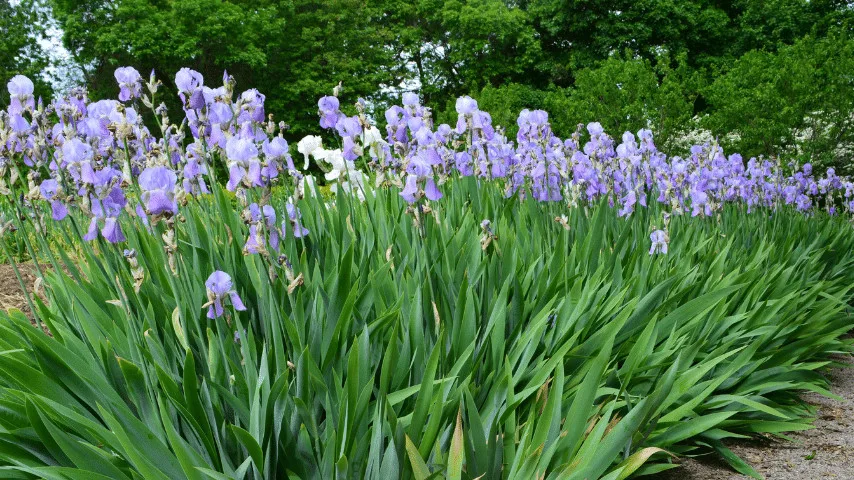
Irises are an excellent selection for planting beneath a hardwood tree
Irises are an excellent selection for planting beneath a hardwood tree since they flower early in the year and have shallow roots.
This is the tool you use when you want to minimize harming preexisting tree roots.
- Scientific Name: Iris sibirica
- Size: 1 to 3 feet (0.3-0.9 m) tall
- Zones: USDA hardiness zones 2-9
- Fertilizer: All-purpose Garden fertilizer in early spring
- Growth rate: Moderate
- Temperature: -4 degrees Fahrenheit (-20 degrees Celsius)
- Lighting: Partial shade to full sun
- Humidity: Moderate
18. Lesser Periwinkle
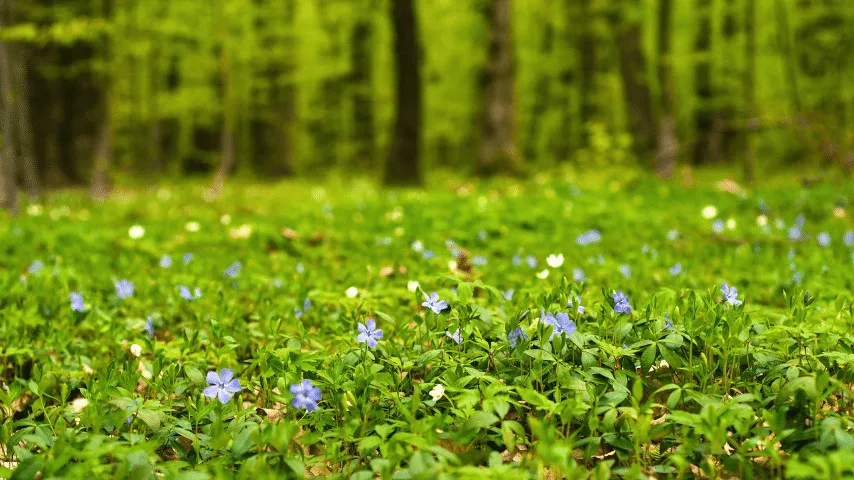
Lesser Periwinkle is wonderful for land cover under trees
It’s also called Vinca minor, and landscape expert Raine Clarke-Wills of Raine Garden Design describes it as a lovely plant and wonderful for land cover under trees.
It will develop to produce a thick mat in dappled shade under leafy covers and will do well in shady areas. It blooms from mid-spring to early autumn.
However, its foliage remains green all year, providing aesthetic intrigue and color. White flowering variants are also available.
- Scientific Name: Vinca minor
- Size: 3 to 0.5 feet (0.09-0.15 m)
- Zones: USDA hardiness zones 3-9
- Fertilizer: Balanced fertilizer monthly
- Growth rate: Fast grower
- Temperature: 20 to 28 degrees Fahrenheit (-6 to -2 degrees Celsius)
- Lighting: Prefer shade but can grow in full sun
- Humidity: Moderate
19. Bloodroot
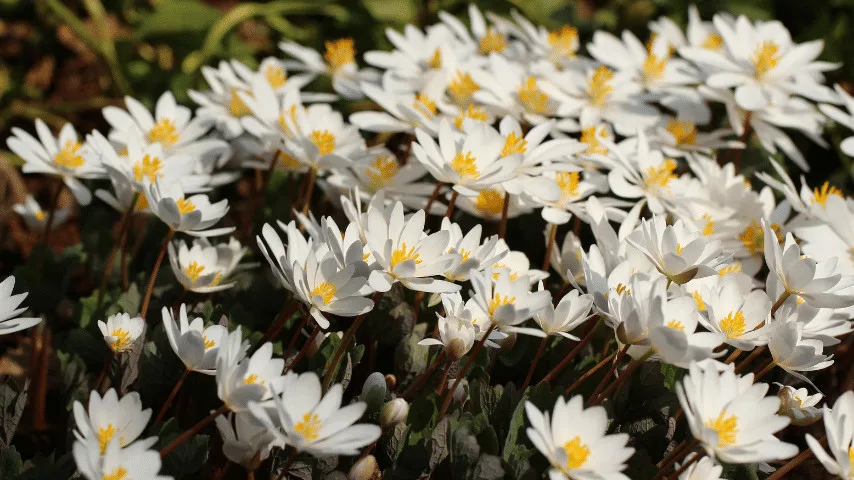
The bloodroot flower is a fantastic way to adorn spaces under trees and is suitable for various shaded places
The bloodroot flower is a fantastic way to adorn spaces under trees and is suitable for various shaded places.
This plant has a beautiful rosette of white flowers that seem much better when paired with the clasping foliage.
Bloodroot blends in well with the look of forest gardening and can even be used in partly shaded areas.
- Scientific Name: Sanguinaria
- Size: 8 feet (0.24 m) tall
- Zones: USDA hardiness zones 3-8
- Fertilizer: Balanced fertilizer in the second year of growth
- Growth rate: Slow grower
- Temperature: Above 46 degrees Fahrenheit (7 degrees Celsius)
- Lighting: Semi-shade but can grow in full sun
- Humidity: Moderate
20. Rheinland Astilbe
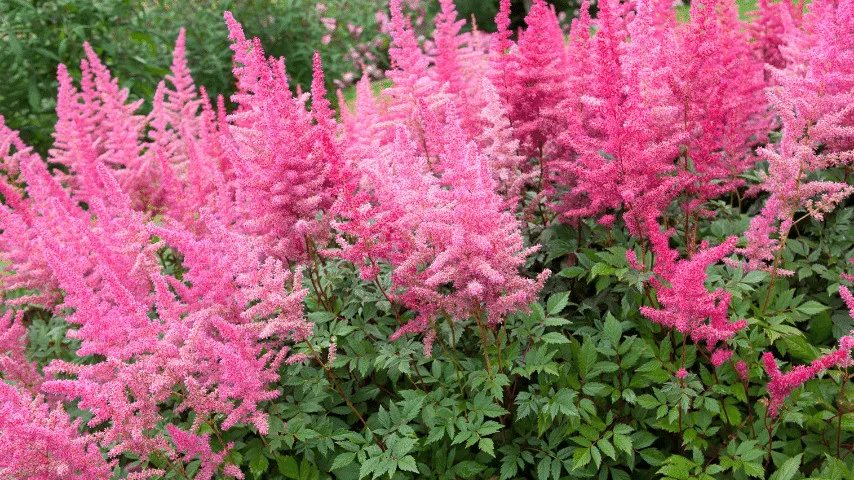
Astilbe red, fuchsia, violet, or white, makes a bold visual impact to recreate beneath trees
Grow a cluster of astilbes in a shaded garden corner for a bold color impression.
Astilbe, which comes in red, fuchsia, violet, or white, makes a bold visual impact that is otherwise difficult to recreate beneath trees.
- Scientific Name: Astilbe x arendsii ‘Rheinland’
- Size: 1 to 2 feet (0.3-0.6 m) tall
- Zones: USDA hardiness zones 3-8
- Fertilizer: Slow-release flower fertilizer
- Growth rate: Moderate
- Temperature: 55 to 60 degrees Fahrenheit (12-15 degrees Celsius)
- Lighting: Partial shade
21. Comfrey
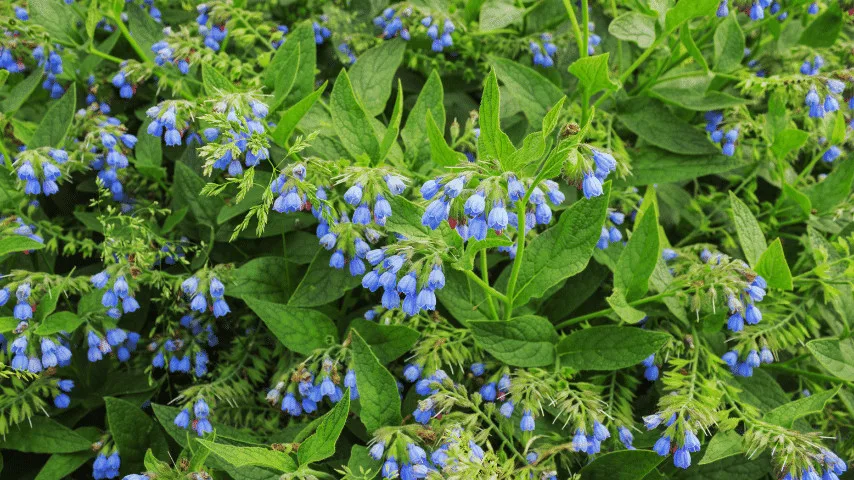
Comfrey plants are popular for covering spaces among shrubs and may thrive beneath the trees
Comfrey plants are popular for covering spaces among shrubs and may thrive in much fewer ideal situations, such as beneath the trees.
In comparison to other crops, they develop fairly quickly. Despite its appearance as a shrub, comfrey is connected to the small but similarly shaped borage plant.
- Scientific Name: Symphytum
- Size: 1 to 3 feet (0.3-0.9 m) tall
- Zones: USDA hardiness zones 3-9
- Fertilizer: Organic fertilizer
- Growth rate: Fast-growing
- Temperature: -40 degrees Fahrenheit below zero without winter kill
- Lighting: Full sun to partial shade
- Humidity: 62%
22. Lamium
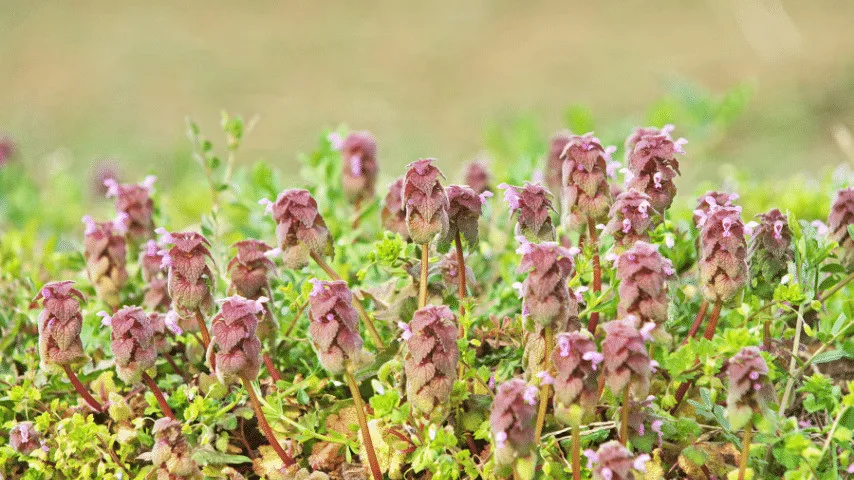
Lamium is a pink and blue-tinged variation, a spring annual that blooms beneath trees
Lamium is a spring annual that blooms sooner, and We especially adore the pink and blue-tinged variation.
Although they’re not intended to be cut blooms, you can use these in bouquets sometimes since they’re so lovely.
- Scientific Name: Lamium
- Size: 6 to 2 feet (0.2-0.6 m) tall
- Zones: USDA hardiness zones 2-9
- Fertilizer: Balanced fertilizer twice a year
- Growth rate: Fast grower
- Temperature: 70 to 75 degrees Fahrenheit (21-23 degrees Celsius)
- Lighting: Partial shade
- Humidity: Moderate
23. Ivory Prince Lenten Rose
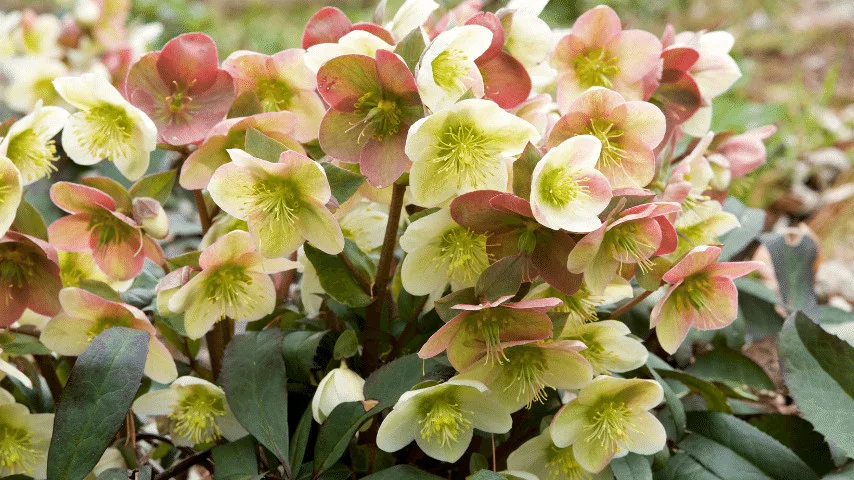
Hellebores are usually a good option for shaded spots
Hellebores are usually a good option for shaded spots. They have everlasting leaves and, according to the variety, blossom from early winter to mid-spring.
Ivory Prince Lenten Rose has tough leaves and milky white petals and is a short, growing variety.
- Scientific Name: Helleborus x hybridus ‘Walhelivor’
- Size: 1 to 1.5 feet (0.3-0.4 m) tall
- Zones: USDA hardiness zones 3-8
- Fertilizer: Time-release acid fertilizer
- Growth rate: Moderate
- Temperature: 45 to 55 degrees Fahrenheit (7-12 degrees Celsius)
- Lighting: Partial to full sun
- Humidity: Moderate
24. Foxglove
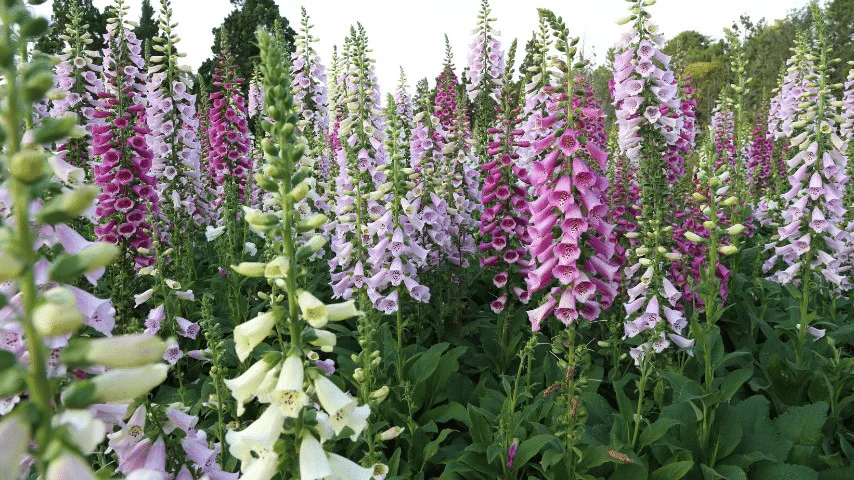
Foxglove plants are suitable for planting in dark locations because they appreciate the shaded surroundings under trees
Foxglove plants are suitable for planting in dark locations because they appreciate the shaded surroundings under trees.
The foxglove blooms grow vertically compared to other flowers, allowing them to pop out more clearly in the landscape.
- Scientific Name: Digitalis
- Size: 2 to 5 feet (0.6-1.5 m) tall
- Zones: USDA hardiness zones 4-10
- Fertilizer: Slow-release fertilizer
- Growth rate: Medium
- Temperature: Over 90 degrees Fahrenheit (32 degrees Celsius)
- Lighting: Full sun to light shade
- Humidity: They grow well in both dry and humid environments
25. Japanese Spurge
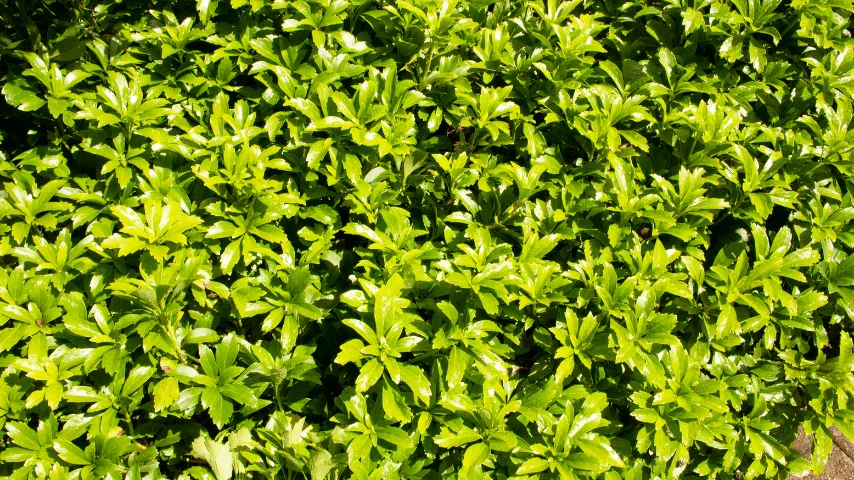
Japanese Spurge forms a 2-inch dense blanket in wooded environments when fully grown
Japanese Spurge forms a 2-inch dense blanket in wooded environments when fully grown.
In some regions, it, as with most ground coverings, can become out of hand. It doesn’t like it when it’s too dry.
- Scientific Name: Pachysandra terminalis
- Size: 3 feet (0.1 m) tall
- Zones: USDA hardiness zones 4-8
- Fertilizer: Slow-release fertilizer
- Growth rate: Slow
- Temperature: -30 to -20 degrees Fahrenheit (-34 to -29 degrees Celsius)
- Lighting: Partial shade to full sun
- Humidity: Moderate
26. Daffodil
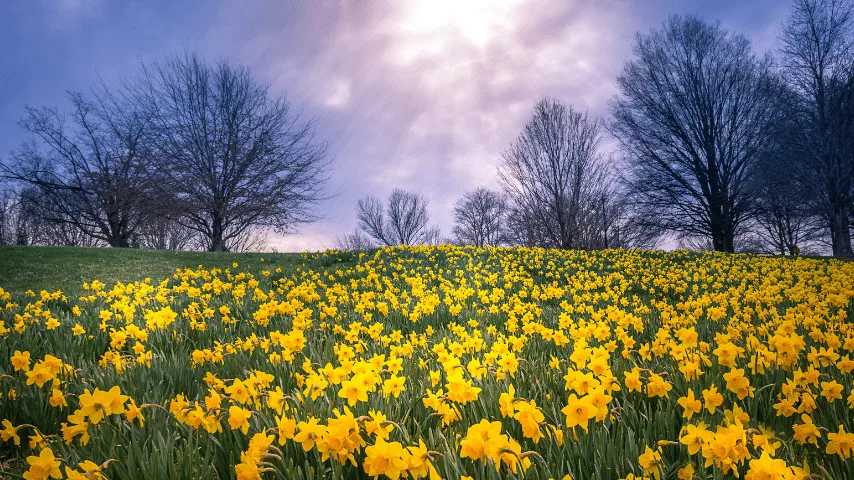
Daffodils may brighten up the dull space beneath your trees
Daffodils may brighten up the dull space beneath your trees. These plants are well-known for their early-blooming flowers in the springtime.
This could be advantageous since the daffodils can achieve their sunshine needs before the tree develops foliage and casts shade on the ground.
- Scientific Name: Narcissus
- Size: 5 to 2.5 foot (0.1-0.7 m) tall
- Zones: USDA hardiness zones 3-8
- Fertilizer: Liquid fish emulsion fertilizer
- Growth rate: Medium
- Temperature: Hardy to -25 degrees Fahrenheit (-32 degrees Celsius)
- Lighting: Full sun to partial shade
- Humidity: High level
27. Coral Bells
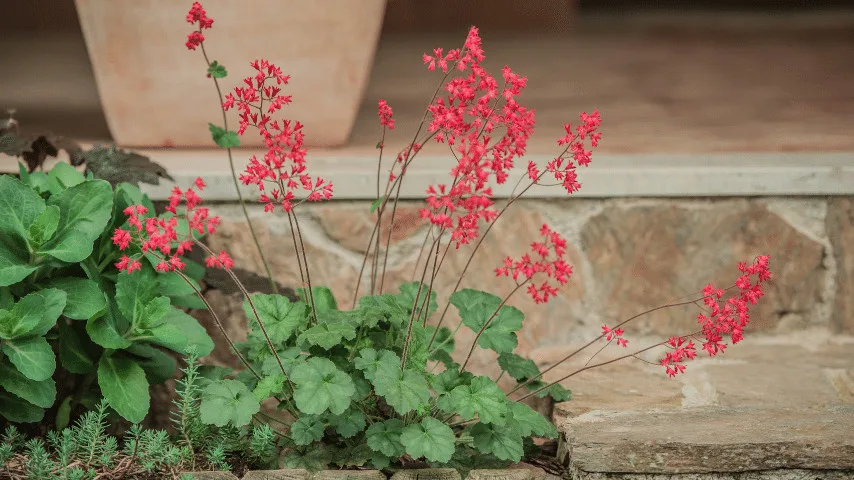
Coral bells can brighten any under-tree space with their gorgeous leaves and vibrant flowers
Coral bells (Heuchera) can brighten any under-tree space with their gorgeous leaves and vibrant flowers.
This plant flowers from springtime through early summer and is fairly resistant. The look of the small spires of bell-shaped blooms gives Heucheras the nickname ‘coral bells.’
- Scientific Name: Heuchera
- Size: 5 to 1.3 foot (0.1-0.4 m) tall
- Zones: USDA hardiness zones 4-9
- Fertilizer: Slow-release granular or water-soluble
- Growth rate: Moderate
- Temperature: Above 45 degrees Fahrenheit (7 degrees Celsius)
- Lighting: Full sun to shade
- Humidity: High
28. Anemones
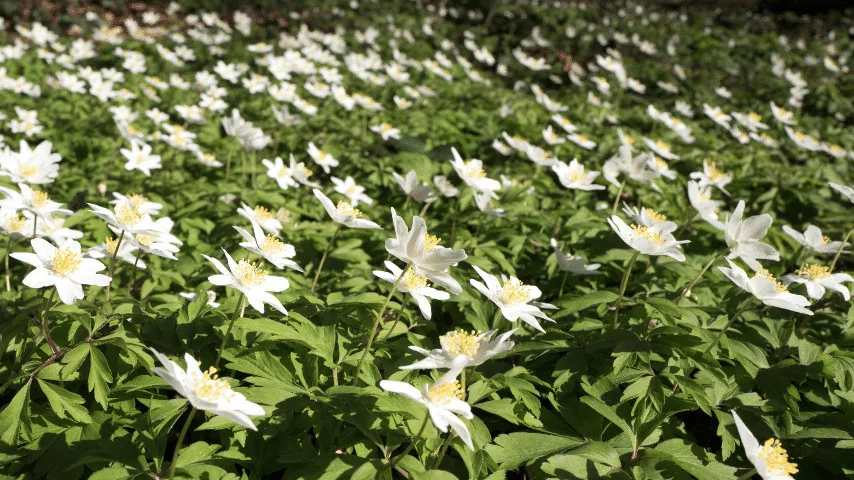
Anemones are the coolest ground covers you can have beneath trees
Anemones are easier to locate, flower for extended periods, and grow out attractively, yet they’re not tough to manage.
They’re probably of the coolest ground covers you can have.
- Scientific Name: Actiniaria
- Size: About 5 feet (1.5 m)
- Zones: USDA hardiness zones 3-10
- Fertilizer: Organic garden fertilizer
- Temperature: 74 to 80 degrees Fahrenheit (23-26 degrees Celsius)
- Lighting: Full to partial sun
- Humidity: Moderate
29. Golden Japanese Forest Grass
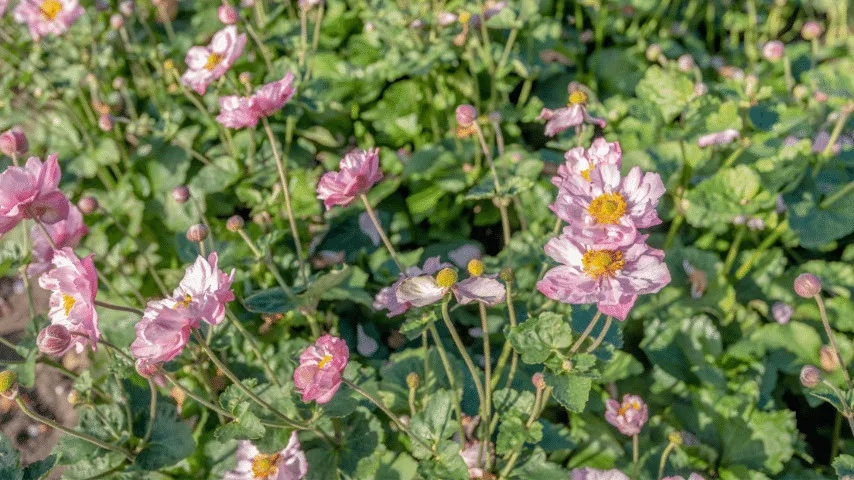
Golden Japanese Forest Grass develops in shaded environments such as beneath trees
Although most grasses dislike being in the shadow, Japanese Forest Grass, often referred to as Hakone Grass, seems to be an exception.
Due to their vibrant colors, beautifully arched branches, and expanding growth patterns, certain colorful varieties, such as Golden Japanese Forest Grass, develop especially pleasant accents to shaded environments.
- Scientific Name: Hakonechloa macra
- Size: 2 feet (0.6 m) tall
- Zones: USDA hardiness zones 5-9
- Fertilizer: Once in spring
- Growth rate: Slow grower
- Lighting: Partial shade
- Humidity: Moderate
30. Wild Ginger
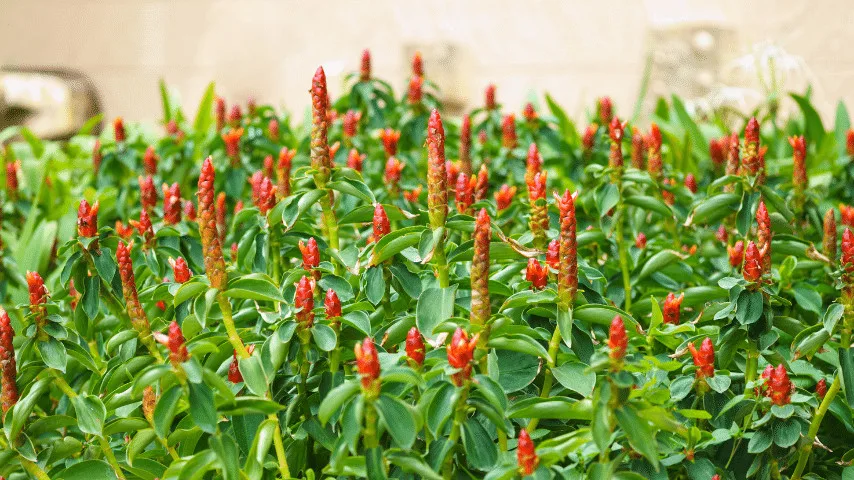
Wild Ginger is good for low-maintenance houseplants that thrive in the shade of the trees
Wild ginger is good for low-maintenance houseplants that thrive in the shade. The blossoms of this plant aren’t particularly noticeable, but the leaves are lovely, with heart-shaped leaflets.
The plant is not connected to the edible ginger, perhaps because of its title.
- Scientific Name: Asarum
- Size: 5 to 0.8 feet (0.1-0.2 m) tall
- Zones: USDA hardiness zones 4-8
- Fertilizer: All-purpose liquid fertilizer
- Growth rate: Medium
- Temperature: 60 to 65 degrees Fahrenheit (15-18 degrees Celsius)
- Lighting: Partial shade to full sun
- Humidity: High

